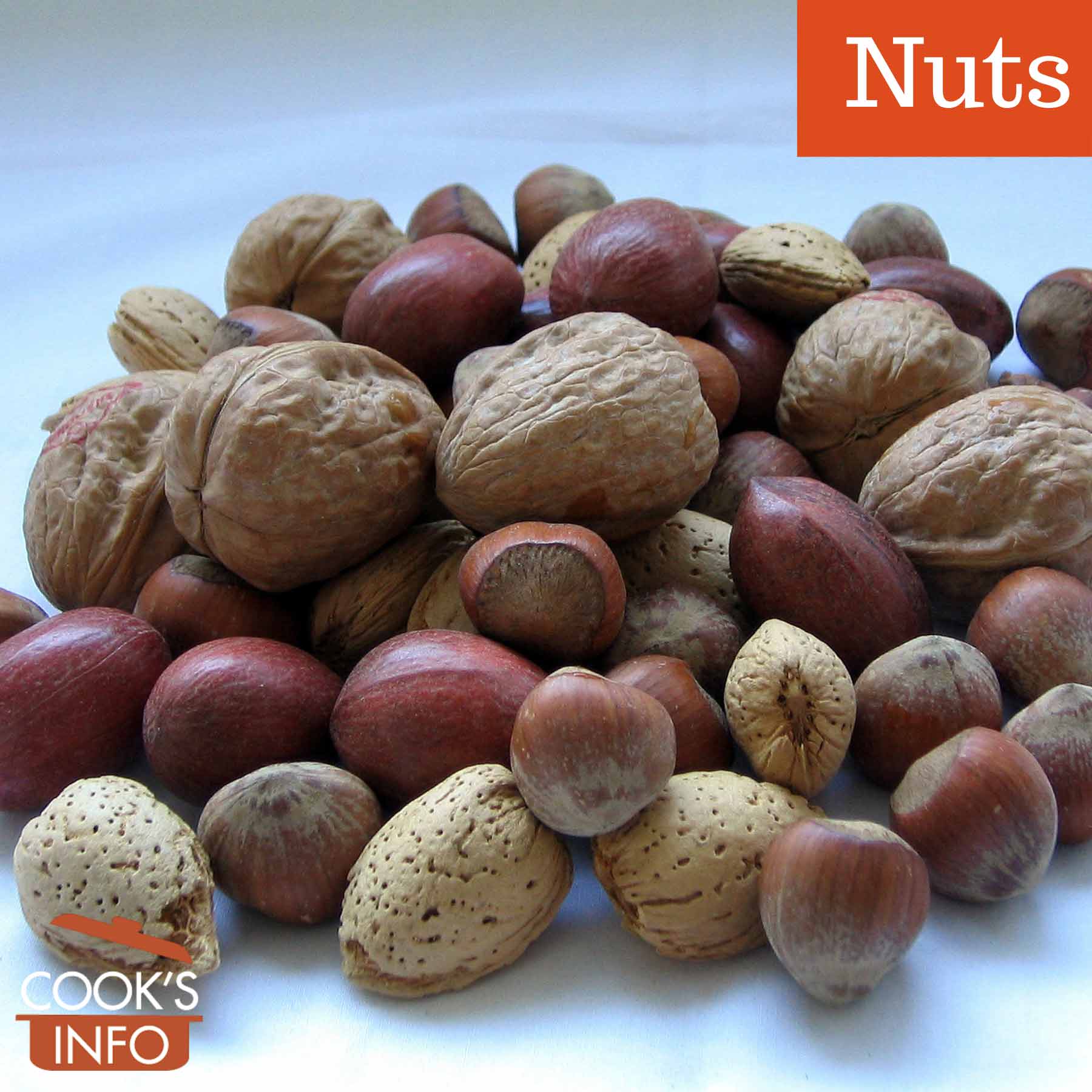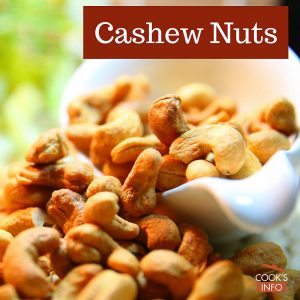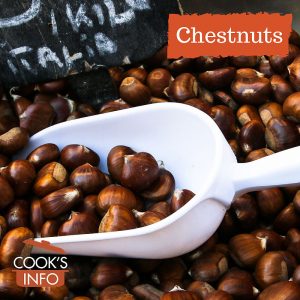
Mixed nuts. © Denzil Green / 2004
A nut is a single-seed covered by a dry shell. The edible part is inside the shell.
Nuts can be eaten out of hand as a snack food, used as an ingredient chopped or whole, pressed to yield oil, or ground into pastes. Food-wise, they provide both nutrition and taste, along with bulking and binding qualities.
Nuts can be regarded as a subsistence food for foragers, but in practice for the rest of us, they can be some of the pricier items on our shopping lists at grocery stores.
On average, nuts have a water footprint of around 9,000 litres per kilogram. [1]Mekonnen, M.M. and Hoekstra, A.Y., “The green, blue and grey water footprint of farm animals and animal products”, Value of Water Research Report Series No. 48, UNESCO-IHE, Delft, the Netherlands. 2010b. Accessed August 2022 at https://research.utwente.nl/en/publications/the-water-footprint-of-food
Culinary category versus botanical category
We call many food items “nuts”, and use them for all intents and purposes as nuts. Many “nuts”, though aren’t technically nuts at all.
True nuts are nuts such as acorns, beechnuts, chestnuts and hazelnuts.
Almonds, Brazil nuts, butternuts, hickory nuts and walnuts all grow inside a fruit, like the stone inside a cherry or a peach. They’re actually a seed covered by a wet fruit covering, and that’s why they’re not true nuts (they’re actually what botanists call “drupes”.)
Other things that we regard as nuts, such as cashews, coconuts, peanuts and pine nuts, aren’t actually nuts, either.
Even though tree nuts grow inside fruit, they are not classified as fruit.
Cooking Tips
Generally nuts can be eaten raw, but are often toasted to enhance their flavour. Sometimes toasting nuts is referred to as “roasting” them.
To toast nuts, place them in a frying pan such as a cast-iron or a non-stick one, with nothing else in the pan (meaning no oil or butter), and heat them for a few minutes over a low heat, stirring them occasionally. Or, bake on an ungreased cookie sheet at 175 C (350 F) for 10 minutes (shake a few times during that).
When chopping nuts in blender or a food processor, if sugar is appropriate for what you are making, you can add a teaspoon or tablespoon of sugar to help prevent them sticking together. Flour will also do the trick.
To crush nuts manually, put them between two pieces of waxed paper or in a plastic bag and roll with a rolling pin.
When cracking nuts in their shells, be careful of flying pieces, especially with regard to your eyes.
Nutrition
Nuts are high in fat, but the fat is considered by nutritionists to be a good fat: apart from coconuts, the fat in nuts is largely unsaturated.
“Nuts are nutrient-dense foods, containing healthy monounsaturated (MUFA) and polyunsaturated (PUFA) fatty acids and proteins. At the same time, they are a good source of soluble and insoluble fibers, vitamins E and K, folate, thiamine, minerals, such as magnesium, copper, potassium and selenium, and substances, such as carotenoids, antioxidants, and phytosterols compounds, with potential benefits for human health. Due to the high energy density of nuts and seeds, it was believed that their consumption could increase weight gain; however, if consumed in the recommended portions, it has been observed that their consumption does not favor weight gain. In contrast, the consumption of nuts can help control satiety and also increase the quality of a diet.” — Oddenino, Martina. University of Turin. Understanding Mediterranean and Okinawa Diets. Step 3.5: Fruit and vegetables. Accessed February 2022 at https://www.futurelearn.com/courses/okinawa-diet/3/steps/1373393
Equivalents
As a general rule, 4 oz. shelled nuts = 125 g = 1 cup, chopped
5 oz. peanuts or mixed nuts = 140 g = 1 cup
3 ¾ oz. pecans, halves = 100 g = 1 cup
4 ½ oz. pecans or walnuts, chopped = 125 g = 1 cup
4 ½ oz. walnuts, chopped = 125 g = 1 cup
1 pound walnuts, in shell = 450 g = 1 ½ cups shelled
Storage Hints
Nuts in their shell have a longer storage life. Shelled nuts should be stored in the fridge or freezer, as they can go rancid faster.
History Notes
Nuts have been a part of December celebrations for millennia. The Romans would give each other small presents including nuts at Saturnalia, and gamble for them; the nut tradition got absorbed with Saturnalia into Christmas and is still a tradition in many European and Middle Eastern Christian cultures. Christians in Syria eat nuts as part of their Christmas dinner; in Europe, for hundreds of years children have received nuts in their Christmas stockings.
Literature & Lore
“I have a venturous fairy that shall seek the squirrel’s hoard, and fetch thee new nuts.” — Titania. A Midsummer Night’s Dream. Act IV, Scene 1. Shakespeare.
Language Notes
Shelled nuts are sometimes referred to as “Nut meats”.
Types of Nuts
See also: Nut flour; Nut meal.
Acorn Starch Jelly
Acorns
Almonds
Amalou
Brazil Nuts
Cashew Nuts
Chestnuts
Coconuts
Fistik Ezmesi
Green Walnuts
Hazelnuts
Macadamia Nuts
Peanuts
Pecans
Pine Nuts
Pistachio Nuts
Tigernuts
Walnuts
References
| ↑1 | Mekonnen, M.M. and Hoekstra, A.Y., “The green, blue and grey water footprint of farm animals and animal products”, Value of Water Research Report Series No. 48, UNESCO-IHE, Delft, the Netherlands. 2010b. Accessed August 2022 at https://research.utwente.nl/en/publications/the-water-footprint-of-food |
|---|




